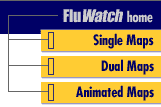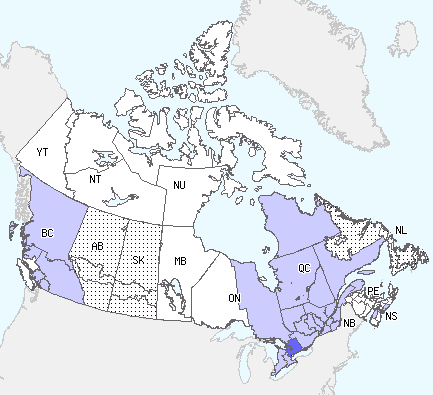Common menu bar links
E-mail this page
Fluwatch
Mostly sporadic or no activity reported in Canada; localized activity still reported in parts of Ontario
During weeks 23 and 24, overall influenza activity in Canada continued to decline with the majority of the provinces and all of the territories reporting only either sporadic activity or no activity in their regions. Localized influenza activity was reported in a few regions in Ontario (see map). The percentage of specimens that tested positive for influenza declined to 1.6% (49/3,007) for Canada as a whole over the two-week period (see table). To date this season, 58% of influenza detections in Canada were for influenza A viruses and 42% were for influenza B viruses. Note that there has been an increase in parainfluenza virus detections since week 21. This week, the ILI consultation rate was 6 ILI consultations per 1,000 patient visits (see ILI graph), which is within the expected range for this week. The sentinel response rate was 29%. No new outbreaks have been reported since week 22.
Antigenic Characterization:
The National Microbiology Laboratory (NML) has characterized 1,334 influenza viruses for the 2007-2008 influenza season: 463 (35%) A(H1N1), 231 (17%) A(H3N2) and 640 (48%) B viruses. Of the 463 influenza A(H1N1) viruses characterized, 441 (95%) were antigenically similar to A/Solomon Islands/3/2006 and 22 (5%) were antigenically similar to A/Brisbane/59/2007. Of the 231 influenza A(H3N2) viruses characterized, 12 (5%) were antigenically similar to A/Wisconsin/67/2005 and 219 (95%) were antigenically similar to A/Brisbane/10/2007. One of the 12 A/Wisconsin-like viruses had reduced titer to A/Wisconsin/67/2005 reference antiserum. Of the 640 influenza B isolates characterized, 17 (3%) were antigenically similar to B/Malaysia/2506/2004 and 623 (97%) were antigenically similar to B/Florida/4/2006 (belonging to the B/Yamagata lineage) (see pie chart).
Antiviral Resistance:
Since the start of the season, the NML has tested 979 influenza A isolates (545 H1N1 and 434 H3N2) for amantadine resistance and found that 432 (99.5%) of the 434 H3N2 isolates were resistant to amantadine and 6 (1%) of 545 H1N1 isolates were resistant (see recommendation from the 2006-2007 influenza season).
The NML has also tested 1,348 influenza isolates (486 A/H1N1, 231 A/H3N2 & 631 B) for oseltamivir (Tamiflu) resistance and found that 127 (26%) of the 486 H1N1 isolates tested were resistant to oseltamivir. Resistant isolates were detected in all 10 provinces. Of the 127 resistant viruses, 123 were A/Solomon Islands/3/06/-like and 4 were A/Brisbane/59/07-like. These oseltamivir resistant strains remain sensitive to the antiviral amantadine.
Influenza-associated Paediatric Hospitalizations:
In weeks 23 & 24, there were 4 new laboratory-confirmed influenza-associated paediatric hospitalizations reported through the Immunization Monitoring Program Active (IMPACT) network: two from AB and ON (influenza A) and the other two from QC (influenza B). Of the 490 hospitalizations reported so far this season, 63% (310/490) have been due to influenza A. The proportion of cases to date by age group are as follows: 21% were 0-5 month olds; 26% were 6-23 month olds; 23% were 2-4 year-olds; 20% were 5-9 year-olds; and 10% were 10-16 year-olds. Since the start of the season, 2 influenza-associated pediatric deaths have been reported to PHAC.
International:
WHO: During the weeks 22–23, the level of overall influenza activity in the world was low. Countries in the northern hemisphere reported sporadic or no activity. In the southern hemisphere, influenza activity remained moderate. A rise of influenza activity was observed in New Zealand.
EISS: In weeks 22-23 sporadic laboratory confirmed cases were reported in Europe. There have been no reports of unusual influenza activity in Europe at a community level since week 16/2008.
Human Avian Influenza: On 19 June 2008, the WHO reported two new cases of human H5N1 avian influenza infection in Indonesia. The cases were not linked epidemiologically. The first case, a 16-year-old female from South Jakarta, DKI Jakarta Province developed symptoms on 7 May, was hospitalized on 12 May and died on 14 May. Investigations into the source of her infection indicate exposure to sick and dead poultry. The second case, a 34-year-old female from Tangerang District, Banten Province developed symptoms on 26 May, was hospitalized on 2 June and died on 3 June. Investigations into the source of her infection are ongoing.
Total number of influenza tests performed and number of positive tests by province/territory of testing laboratory, Canada, 2007-2008
| Province
of reporting laboratories |
Report
Period: June 1, 2008 to June 14, 2008 |
Season
to Date: August 26, 2007 to June 14, 2008 |
||||||
| Total
# Influenza Tests |
# of Positive Tests | Total
# Influenza Tests |
# of Positive Tests | |||||
| Influenza A | Influenza B | Total | Influenza A | Influenza B | Total | |||
| NL | 48 | 1 | 0 | 1 | 1461 | 85 | 133 | 218 |
| PE | 7 | 0 | 0 | 0 | 171 | 3 | 26 | 29 |
| NS | 20 | 0 | 0 | 0 | 1094 | 123 | 104 | 227 |
| NB | 29 | 0 | 0 | 0 | 1578 | 108 | 193 | 301 |
| QC | 681 | 7 | 5 | 12 | 31317 | 2236 | 1151 | 3387 |
| ON | 760 | 8 | 15 | 23 | 36705 | 2490 | 1809 | 4299 |
| MB | 70 | 0 | 0 | 0 | 2409 | 82 | 45 | 127 |
| SK | 132 | 0 | 0 | 0 | 6446 | 366 | 311 | 677 |
| AB | 1220 | 9 | 4 | 13 | 32609 | 956 | 945 | 1901 |
| BC | 40 | 0 | 0 | 0 | 3709 | 589 | 477 | 1066 |
| Canada | 3007 | 25 | 24 | 49 | 117499 | 7038 | 5194 | 12232 |
Specimens from NT, YT, and NU are sent to reference laboratories in other provinces.
Note: Cumulative data includes updates to previous weeks; due to reporting delays, the sum of weekly report totals do not add up to cumulative totals.
Abbreviations: Newfoundland/Labrador (NL), Prince Edward Island (PE), New Brunswick (NB), Nova Scotia (NS), Quebec (QC), Ontario (ON), Manitoba (MB), Saskatchewan (SK), Alberta (AB), British Columbia (BC), Yukon (YT), Northwest Territories (NT), Nunavut (NU)
Respiratory virus laboratory detections in Canada, by geographic
regions, are available weekly on the following website:
<http://www.phac-aspc.gc.ca/bid-bmi/dsd-dsm/rvdi-divr/index-eng.php>
Number of influenza surveillance regions† reporting widespread or localized influenza activity, Canada, by report week, 2007-2008 (N=54)
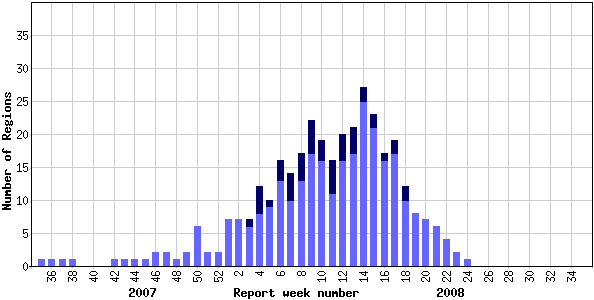
![]()
† sub-regions within the province or territory as defined by the provincial/territorial epidemiologist. Graph may change as late returns come in.
Influenza
Activity Level by Provincial and Territorial |
||||||||||||
|
||||||||||||
Note: Influenza activity levels, as represented on this map, are assigned and reported by Provincial and Territorial Ministries of Health, based on laboratory confirmations, sentinel ILI rates (see graphs and tables) and outbreaks. Please refer to detailed definitions. For areas where no data is reported, late reports from these provinces and territories will appear on the FluWatch website. Select single maps by report week to get this updated information.
<http://dsol-smed.phac-aspc.gc.ca/dsol-smed/fluwatch/fluwatch.phtml?lang=e>
Click on the map to view provinces/territories and maps for other weeks.
Influenza tests reported and percentage of tests positive, Canada, by report week, 2007-2008
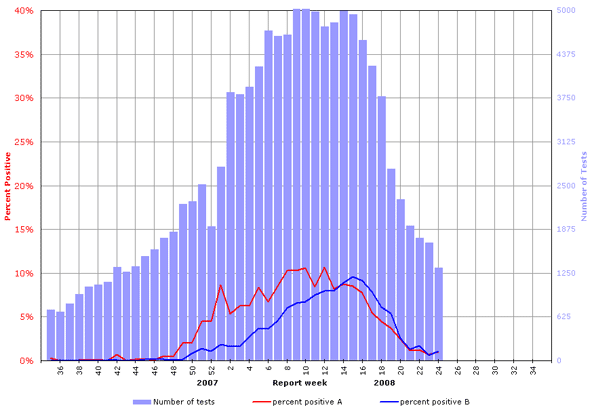
Percent positive influenza tests, compared to other respiratory viruses, Canada, by reporting week, 2007-2008
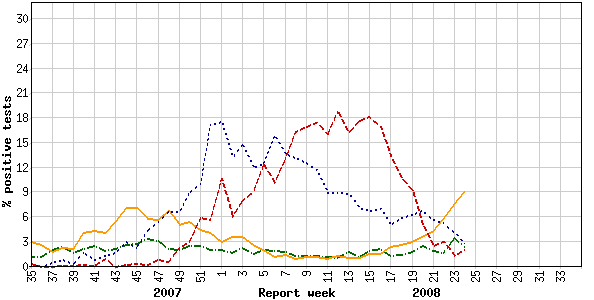
![]()
Influenza strain characterization, Canada, cumulative, 2007-2008 influenza season by the Respiratory Viruses Section at the National Microbiology Laboratory
[N=1,334]

{Strain characterization, number identified, per cent of total number}
NACI recommends that the trivalent vaccine for the 2007-2008 season in Canada contain A/Solomon Islands/3/2006 (H1N1)-like virus; an A/Wisconsin/67/2005 (H3N2)-like virus; and a B/Malaysia/2506/2004-like virus.
Influenza-like illness (ILI) consultation rates, Canada, by report week, 2007-2008 compared to 1996/97 through to 2006/07 seasons

![]()
Note: No data available for mean rate in previous years for weeks 19 to 39 (1996-1997 through 2002-2003 seasons).
Number of New Outbreaks in Long Term Care Facilities, Canada, by Report Week, 2007-2008
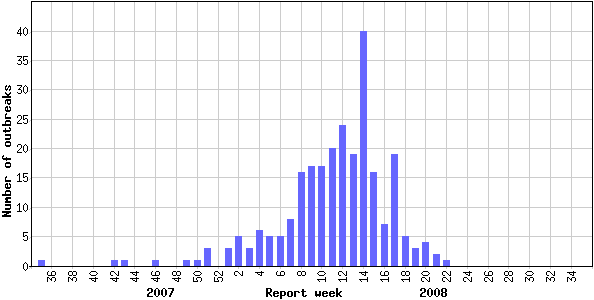
![]()
Please note that the above graphs may change as late returns come in.


